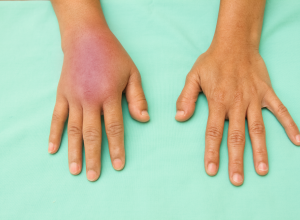
Inflammation (Acute and Chronic)
Inflammation is the body’s natural way to deal with harmful stimuli such as injury, bacteria, viruses, and other irritants and pathogens. The redness and swelling typically symptomatic of inflammation is the body’s immune cells and blood vessels doing their best to ward off further damage to the area. This involves clearing out the necrotic cells and tissues damaged by the irritant and beginning the process of tissue repair.
Acute Versus Chronic Inflammation
Acute inflammation is the body’s initial and generic response to infection, injury and anything else that causes irritation. It involves the body moving increased amounts of plasma and leukocytes into the injured tissue. It typically shows itself via pain, redness, swelling and a hot sensation in the area. Sometimes loss of function can occur. The acronym often used to describe these symptoms is PRISH (pain, redness, immobility, swelling and heat). The onset of acute inflammation is generally immediate, and it persists for a few days.
Prolonged inflammation is called chronic inflammation, and this generally leads to a shift in the type of cells present in the affected area. It is usually the body’s response to persistent acute inflammation due to indestructible pathogens, viral infection and persistent foreign bodies like splinters that aren’t removed.
In some cases, chronic inflammation is due to autoimmune diseases in which the body somehow becomes confused and attacks normal cells and tissues as if they are infected or abnormal. An example of this is certain types of inflammatory arthritis. The body’s immune system triggers an inflammatory response when there is no injury, pathogen or foreign invader to fight off. The onset of chronic inflammation is generally delayed and it can persist for several months or even years.
Too little acute inflammation can allow a bacteria, virus or other irritant to further damage the body, while chronic inflammation can lead to diseases like atherosclerosis, cancer, hay fever and rheumatoid arthritis. Therefore, the body usually tries to regulate the level of inflammation fairly closely.
Causes
There are many causes of inflammation, falling into four categories:
- Physical: Some physical causes of inflammation include injury, burns, foreign objects such as splinters puncturing the skin, frostbite and ionizing radiation.
- Chemical: Some chemical causes of inflammation include toxins and other chemical irritants invading the body.
- Biological: Inflammation is a common response to biological irritants like bacteria, viruses and other pathogens, as well as stress and hypersensitivity.
- Psychological: In some cases, psychological conditions like excitement and embarrassment can cause inflammation.
Types
In addition to acute and chronic inflammation, there are specific types of inflammation that can affect the body. They include:
- Appendicitis, which is inflammation of the appendix Bursitis, which is inflammation of the body’s bursae (small sacs) of synovial fluid
- Colitis, which is inflammation of the colon
- Cystitis, which a urinary tract infection (bladder infection)
- Dermatitis, which is inflammation of the skin (also known as eczema)
- Phlebitis, which is inflammation of a vein
- CRPS/RSD/RND (complex regional pain syndrome, formerly reflex sympathetic dystrophy or reflex neurovascular dystrophy), which is a chronic systemic disease
- Rhinitis, which is inflammation of the mucous membrane inside the nose
- Tendontis, which is inflammation of a tendon Tonsilitis, which is inflammation of the tonsils
- Vasculitis, which is inflammation of blood vessels
Treatment
Treatment of inflammation largely depends on the type of inflammation present. It is important to note that though infection can cause inflammation, the two are not the same thing and they are treated very differently.
If your foot or ankle is inflamed, your podiatrist, orthopaedic surgeon, or foot and ankle doctor can help you determine the cause of inflammation. Meanwhile, it is suggested by many, including sites like WebMD and MedicineNet, that if you are experiencing foot or ankle inflammation, you should follow the RICE protocol, which is rest, icing the area, compression with an ankle wrap or bandage, and elevation of the foot just above your heart to help reduce swelling. You may also want to take a nonsteroidal anti-inflammatory drug (NSAID) like ibuprofen.
Notice concerning medical entries:
Articles having medical content shall serve exclusively for the purpose of general information. Such articles are not suitable for any (self-) diagnosis and treatment of individual illnesses and medical indications. In particular, they cannot substitute for the examination, advice, or treatment by a licensed physician or pharmacist. No replies to any individual questions shall be effected through the articles.






